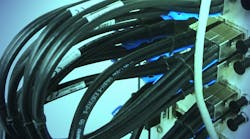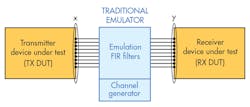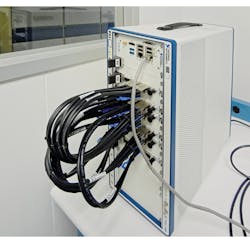Download this article as a .PDF
There is no doubt that the New York University (NYU) WIRELESS academic research center is at the very center of 5G research and development. One specific area that is under investigation with regard to 5G millimeter-wave systems is channel emulation. In fact, NYU WIRELESS recently made headlines by revealing that it has developed what is believed to be the first commercial emulator for 5G millimeter-wave systems. While channel emulation has been used for quite some time, this article explains how researchers at NYU WIRELESS are redefining it for 5G.
Channel Emulation 101
Before discussing channel emulation for 5G systems, it is helpful to first present a brief introduction of channel emulation itself. Aditya Dhananjay, a postdoctoral research fellow at NYU as well as the co-founder and president of MilliLabs, is leading 5G channel emulation efforts at NYU WIRELESS. “Let’s says you are building base stations and cell phones and you want to test them,” Dhananjay says. “One way of testing them is by doing over-the-air (OTA) field trials.
“You take your base station and cell phone out into the real world and you test them to see how they do in different scenarios,” he continues. “Then you can see in the real world if the design is adequate.” Figure 1 shows a basic illustration of OTA testing.
However, OTA field trials have significant drawbacks. “OTA field testing is very time consuming and expensive,” Dhananjay explains. “And the amount of data you can get from field trials is extremely limited. Since the design of wireless communication systems is highly iterative, it’s not good if the testing stage is extremely long and expensive.”
Channel emulation is therefore the common approach for testing wireless systems (Fig. 2). “The alternative to field trials is by utilizing what is known as emulation,” Dhananjay says. “With emulation, you don’t go out into the real world. You keep your transmitter and receiver in the lab and you put an emulator box in the middle.
“Instead of transmitting signals over the air, signals are fed to the emulator using cables,” he continues. “The emulator will modify these signals as if they had gone over the real wireless channel. The resulting signals are then fed to the receiver using cables. So you can sit in the lab and program the emulator for different scenarios. The advantages are that you don’t have to leave the lab and the results are highly reproducible. You can really test and see where your designs are working and where they are going wrong.
“The bottom line is that emulators are a critical tool,” Dhananjay adds. “They have been used for the design of wireless systems for a long time. 2G, 3G, 4G, and Wi-Fi systems have all been developed using channel emulators.”
Focusing on 5G
As mentioned, channel emulators have been used to design wireless systems for a long time. However, the focus now shifts to 5G communications. Are there emulators for 5G systems? The answer is no, says Dhananjay, noting that these systems are going to be fundamentally different from existing wireless technologies.
“The part of the 5G ecosystem we are talking about is millimeter-wave frequencies,” he elaborates. “With the millimeter-wave bands, you now have huge amounts of bandwidth. That’s the first difference—the bandwidths are extremely large.”
He continues: “The second difference is that the number of antennas you are going to have on your transmitter and receiver is extremely large in comparison to 4G systems.” Specifically, phased-array antennas are expected to be an important aspect of 5G, as they will be used to overcome the high path losses at millimeter-wave frequencies.
The points mentioned explain why the traditional emulation model is not suitable for 5G systems. “If you were to take the traditional emulation model and just scale it up for 5G systems, there are a number of problems,” Dhananjay explains. “You might easily have 256 antennas on the base station side and 64 antennas on the user equipment (UE) side. Surely, you are not going to connect that many cables from the transmitter to the emulator and from the emulator to the receiver—that’s not even possible. And even if you had that many cables and wanted to do it, there is no simply no way of connecting cables to a phased-array antenna. So there’s no mechanism available to connect the antennas to the emulator.”
Furthermore, the challenges actually extend beyond the reasons already stated. “Even if someone comes up with some technology that enables you to connect a phased array to a box using cables, the emulator would still be incredibly hard to build,” he adds. “The reason why is the computational complexity of the emulator goes through the roof. If the number of antennas goes up by two orders of magnitude and the bandwidth also goes up by two orders of magnitude, the computational complexity of the emulator goes up by four orders of magnitude.”
What is the actual meaning of computational complexity with regard to channel emulators? Dhananjay explains: “Computational complexity boils down to multipliers, which are the most basic hardware component that you need to build an emulator. The number of multipliers that you need is actually a function of the number of antennas in the transmitter and receiver. Even if you were to do the emulation in the most efficient manner possible, the number of multipliers you are going to need is huge. So the hardware costs are going to rise and become impossible.”
A New Paradigm in Channel Emulation
So how exactly can one build a channel emulator for 5G millimeter-wave systems? Dhananjay and his team believe they have the solution. Figure 3 shows a block diagram of this new 5G emulator, which they say is a “new paradigm” in channel emulation. The most notable difference is that the emulator actually includes the multi-antenna front ends.
“The emulator is going to emulate the antennas in addition to emulating the wireless channel. In this new emulation paradigm, you get rid of the front ends altogether,” Dhananjay says. “You take the emulator box and put it in the middle. Instead of the transmitter telling its phased-array which direction to beamform, the transmitter tells the emulator which direction to beamform.
“Similarly,” he continues, “instead of the receiver telling its phased-array where to beamform, the receiver tells the emulator which direction to beamform. Essentially, the emulator not only emulates the wireless channel, but also the phased-array front ends on both sides.”
While the team originally built the emulator for internal research, they later realized it has commercial viability. “We built this emulator because we needed a 5G emulator and there were just no solutions out there,” Dhananjay recalls. “But then we realized that it actually has commercial promise. The emulator is built entirely with commercial-off-the-shelf (COTS) components from National Instruments (NI). In fact, NI gave us this hardware as part of a donation.” Figure 4 shows the actual 5G emulator hardware.
In summary, Dhananjay and his team are clearly engaged in groundbreaking work in the area of 5G millimeter-wave channel emulation. This article shed some light on the new channel emulation approach for 5G. This area is certainly one to watch as researchers strive to make 5G a reality.





